Figure 4. WWP1 interacts with TRAF6, but not IRAK1, both in vitro and in vivo.
(A) WWP1 interacted with TRAF6, but not IRAK1, in the mammalian over-expression system. HEK293T cells (2×106) were transfected with the His-WWP1 (3 µg) plasmids and Myc-TRAF6 or Myc-IRAK1 plasmids (3 µg). After 24 h, whole cell extracts were immunoprecipitated with anti-His and then analyzed with anti-Myc. Cell lysates were analyzed by immunoblotting with anti-Myc and anti-His. (B) Both wild type WWP1 and C890A could interact with TRAF6 in the mammalian over-expression system. HEK293T cells (2×106) were transfected with the myc-TRAF6 plasmids and His-WWP1 (3 µg) or His- C890A plasmids (3 µg). After 24 h, whole cell extracts were immunoprecipitated with anti-His, and then analyzed with anti-Myc. Cell lysates were analyzed by immunoblotting with anti-Myc and anti-His. (C) Endogenous WWP1 was associated with TRAF6 following LPS stimulation. RAW264.7 cells (3×107) were left untreated or stimulated with LPS (at a final concentration of 400 ng/mL) for the indicated times. Whole cell extracts were immunoprecipitated with IgG and anti-WWP1, and then analyzed with anti-TRAF6 or anti-IRAK1. Cell lysates were also analyzed by immunoblotting with anti-TRAF6 or anti-IRAK1. Data are from one experiment representative of three independent experiments with similar results.

